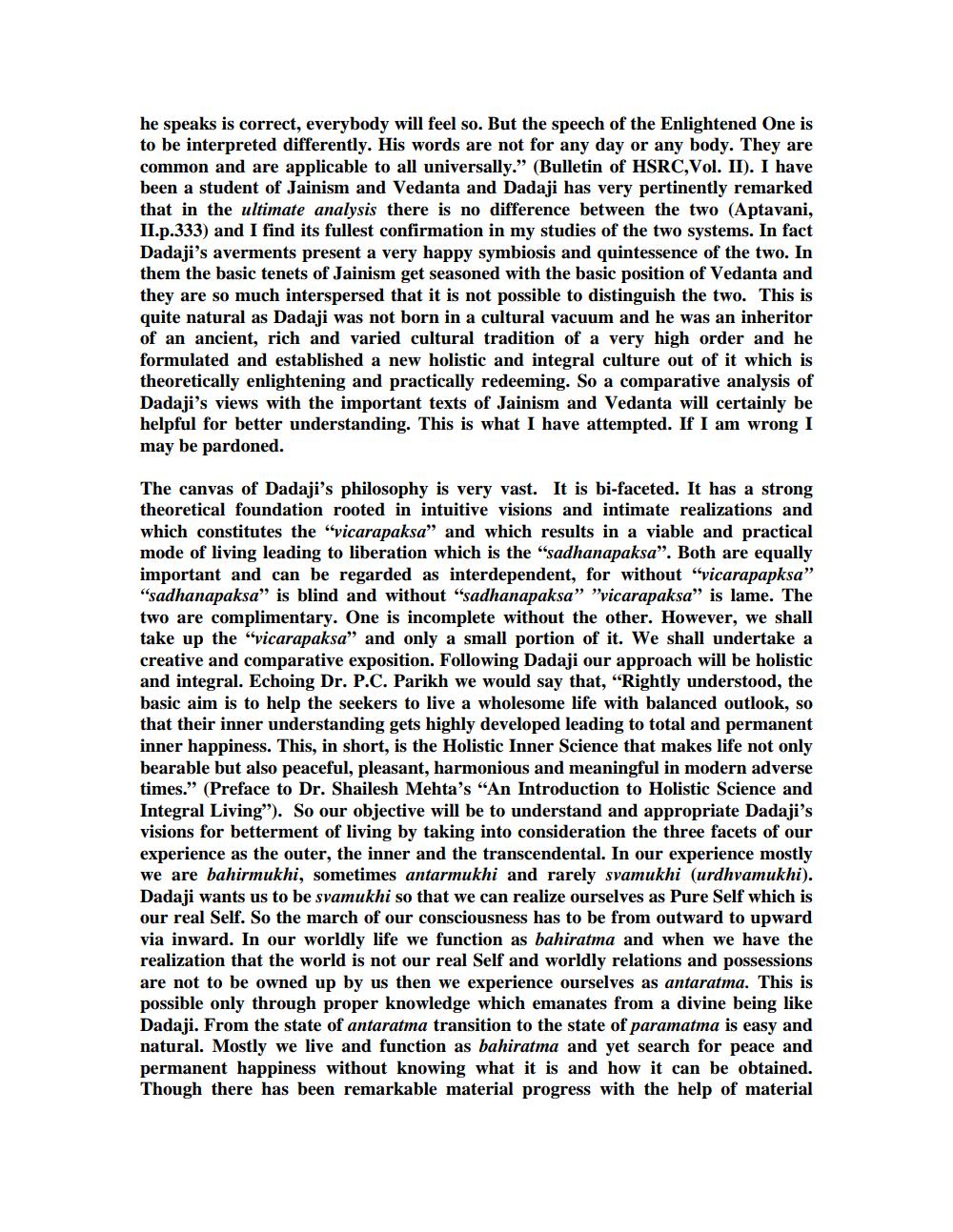Book Title: Concepts of Parmatma Antaratma Anatma in Philosophy of Dada Bhagwan Author(s): S R Bhatt Publisher: S R Bhatt View full book textPage 3
________________ he speaks is correct, everybody will feel so. But the speech of the Enlightened One is to be interpreted differently. His words are not for any day or any body. They are common and are applicable to all universally.” (Bulletin of HSRC, Vol. II). I have been a student of Jainism and Vedanta and Dadaji has very pertinently remarked that in the ultimate analysis there is no difference between the two (Aptavani, II.p.333) and I find its fullest confirmation in my studies of the two systems. In fact Dadaji's averments present a very happy symbiosis and quintessence of the two. In them the basic tenets of Jainism get seasoned with the basic position of Vedanta and they are so much interspersed that it is not possible to distinguish the two. This is quite natural as Dadaji was not born in a cultural vacuum and he was an inheritor of an ancient, rich and varied cultural tradition of a very high order and he formulated and established a new holistic and integral culture out of it which is theoretically enlightening and practically redeeming. So a comparative analysis of Dadaji's views with the important texts of Jainism and Vedanta will certainly be helpful for better understanding. This is what I have attempted. If I am wrong I may be pardoned. The canvas of Dadaji's philosophy is very vast. It is bi-faceted. It has a strong theoretical foundation rooted in intuitive visions and intimate realizations and which constitutes the "vicarapaksa" and which results in a viable and practical mode of living leading to liberation which is the "sadhanapaksa". Both are equally important and can be regarded as interdependent, for without "vicarapapksa" "sadhanapaksa" is blind and without "sadhanapaksa" "vicarapaksa" is lame. The two are complimentary. One is incomplete without the other. However, we shall take up the "vicarapaksa" and only a small portion of it. We shall undertake a creative and comparative exposition. Following Dadaji our approach will be holistic and integral. Echoing Dr. P.C. Parikh we would say that, “Rightly understood, the basic aim is to help the seekers to live a wholesome life with balanced outlook, so that their inner understanding gets highly developed leading to total and permanent inner happiness. This, in short, is the Holistic Inner Science that makes life not only bearable but also peaceful, pleasant, harmonious and meaningful in modern adverse times." (Preface to Dr. Shailesh Mehta's "An Introduction to Holistic Science and Integral Living"). So our objective will be to understand and appropriate Dadaji's visions for betterment of living by taking into consideration the three facets of our experience as the outer, the inner and the transcendental. In our experience mostly we are bahirmukhi, sometimes antarmukhi and rarely svamukhi (urdhvamukhi). Dadaji wants us to be svamukhi so that we can realize ourselves as Pure Self which is our real Self. So the march of our consciousness has to be from outward to upward via inward. In our worldly life we function as bahiratma and when we have the realization that the world is not our real Self and worldly relations and possessions are not to be owned up by us then we experience ourselves as antaratma. This is possible only through proper knowledge which emanates from a divine being like Dadaji. From the state of antaratma transition to the state of paramatma is easy and natural. Mostly we live and function as bahiratma and yet search for peace and permanent happiness without knowing what it is and how it can be obtained. Though there has been remarkable material progress with the help of materialPage Navigation
1 2 3 4 5 6 7 8 9 10 11 12 13 14 15 16 17 18 19 20 21 22 23 24
